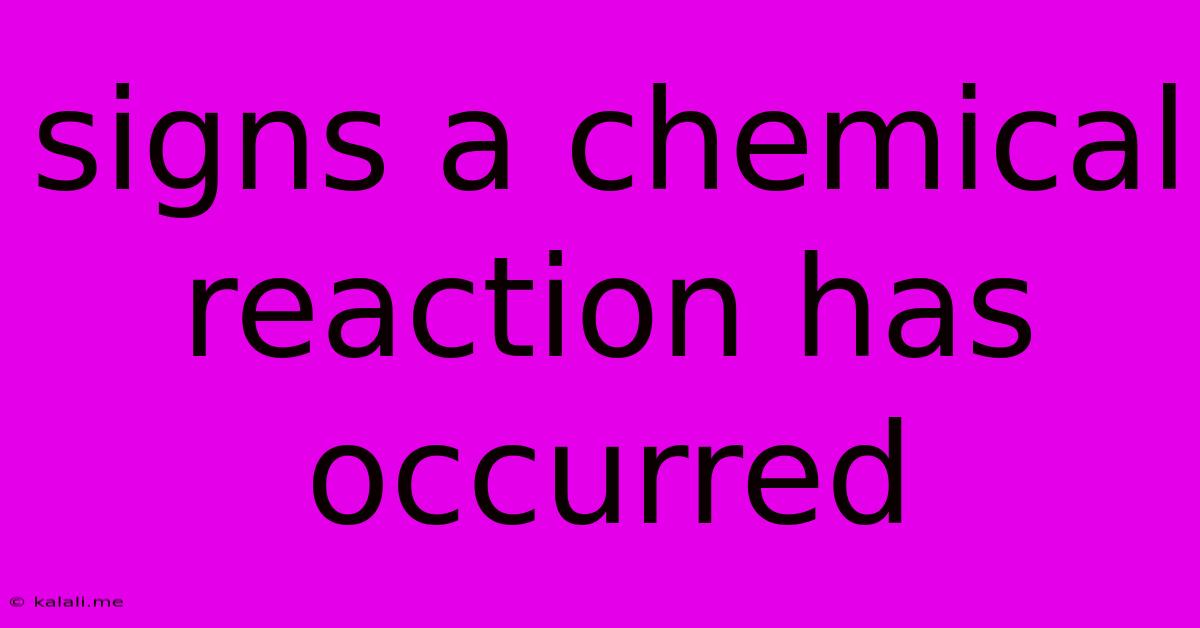Signs A Chemical Reaction Has Occurred
Kalali
May 09, 2025 · 3 min read

Table of Contents
Signs a Chemical Reaction Has Occurred: A Comprehensive Guide
Meta Description: Learn to identify chemical reactions! This guide explores key signs like color change, temperature shift, gas production, precipitate formation, and odor change, helping you understand chemical processes.
Chemical reactions are the foundation of chemistry, driving countless processes in our world. From the rusting of iron to the digestion of food, chemical reactions are constantly occurring. But how do we know a chemical reaction has actually taken place? Identifying these reactions involves recognizing specific observable changes. This article will explore the key signs that indicate a chemical reaction is underway.
1. Change in Color
One of the most visually apparent signs of a chemical reaction is a change in color. This occurs because the chemical composition of the substances involved is altered, resulting in different wavelengths of light being absorbed or reflected. For example, the browning of an apple when exposed to air is a result of oxidation, a chemical reaction that changes the color of the fruit's compounds. Similarly, the dramatic color change observed when mixing certain solutions, like mixing iodine with starch, provides clear evidence of a reaction.
2. Temperature Change (Exothermic and Endothermic Reactions)
Chemical reactions often involve a change in temperature. Exothermic reactions release energy into their surroundings, causing a noticeable increase in temperature. Examples include combustion (burning) and neutralization reactions (acid-base reactions). Conversely, endothermic reactions absorb energy from their surroundings, resulting in a decrease in temperature. The dissolving of some salts in water is a classic example of an endothermic reaction, making the water feel cooler. Measuring temperature changes using a thermometer is a crucial technique in studying reaction kinetics.
3. Formation of a Gas (Effervescence)
The production of gas, often observed as bubbling or fizzing (effervescence), is a strong indicator of a chemical reaction. The gas may be colorless and odorless, like the carbon dioxide released when baking soda reacts with vinegar, or it could have a distinct smell and color, as in certain decomposition reactions. Observing gas formation often requires careful attention to detail, and understanding the properties of gases is essential for interpreting results. This is also related to the release of volatile compounds.
4. Formation of a Precipitate
A precipitate is a solid that forms from a solution during a chemical reaction. This solid is insoluble in the solution and appears as a cloudy suspension or settles out as a solid. For example, the reaction between lead(II) nitrate and potassium iodide produces a yellow precipitate of lead(II) iodide. The formation of a precipitate is often a clear visual cue that a reaction has occurred. Understanding solubility rules is key to predicting whether precipitate formation will occur in a particular reaction.
5. Change in Odor
A change in odor can be another significant indicator of a chemical reaction. The formation of new compounds often results in the production of substances with distinct smells. For instance, the characteristic pungent smell of hydrogen sulfide gas is produced during certain reactions involving sulfur compounds. However, caution must be exercised when relying solely on smell as some gases can be extremely toxic.
6. Light Emission (Chemiluminescence)
In certain chemical reactions, energy is released in the form of light. This phenomenon is known as chemiluminescence. The glow sticks commonly used for entertainment are a great example of this, where the light is produced by a chemical reaction within the stick. The intensity and color of the light emitted can vary depending on the specific reaction.
Distinguishing Physical Changes from Chemical Changes
It's crucial to distinguish between physical changes and chemical changes. Physical changes, such as melting ice or dissolving sugar in water, alter the physical state or appearance of a substance without changing its chemical composition. Chemical reactions, however, result in the formation of new substances with different properties. Observing the signs outlined above will help differentiate between these two types of changes.
Understanding the signs of a chemical reaction is essential for anyone studying chemistry, from high school students to seasoned researchers. By carefully observing and interpreting these indicators, one can gain a deeper appreciation for the dynamic world of chemical transformations.
Latest Posts
Latest Posts
-
How To Graph An Arithmetic Sequence
May 10, 2025
-
What Are The Factors For 4
May 10, 2025
-
How Does Ice Contribute To Erosion
May 10, 2025
-
Compare And Contrast The Inner And Outer Planets
May 10, 2025
-
1000 Km Equals How Many Meters
May 10, 2025
Related Post
Thank you for visiting our website which covers about Signs A Chemical Reaction Has Occurred . We hope the information provided has been useful to you. Feel free to contact us if you have any questions or need further assistance. See you next time and don't miss to bookmark.